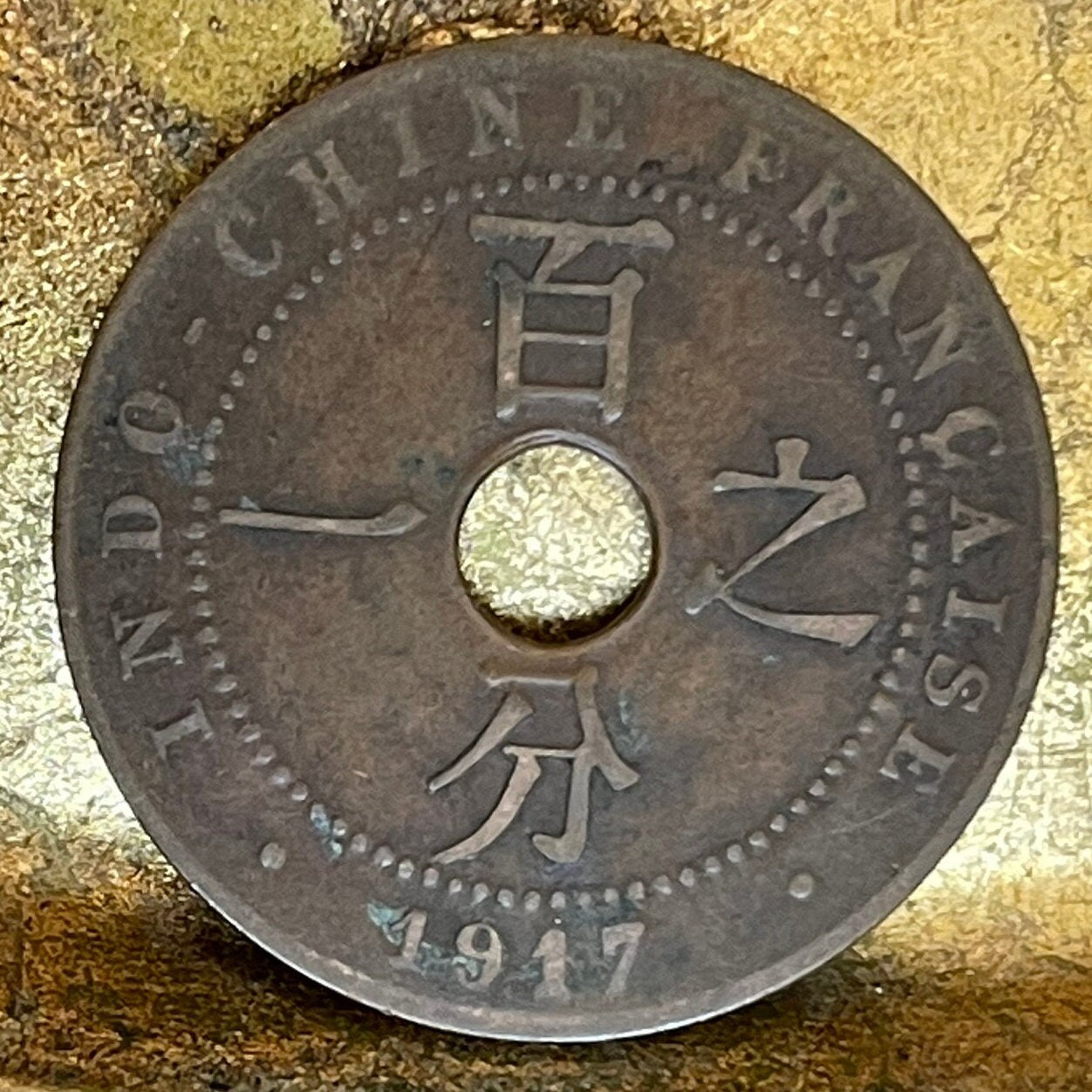elemintalshop
Imperialist Marianne 1 Cent French Indochina Authentic Coin Money for Jewelry (Vietnam) (Phrygian Cap) (Hole in Coin) (Chinese Characters)
Imperialist Marianne 1 Cent French Indochina Authentic Coin Money for Jewelry (Vietnam) (Phrygian Cap) (Hole in Coin) (Chinese Characters)
Couldn't load pickup availability
Imperialist Marianne 1 Cent French Indochina Authentic Coin Money for Jewelry and Craft Making (Vietnam) (Laos) (Cambodia) (French Colonialism) (Phrygian Cap) (Hole in Coin) Chinese Characters)
CONDITION: VERY FINE
Obverse: Marianne, wearing Phrygian Cap of Liberty (that is: portraying an "Allegorical Female France") covers an "Allegorical Female Asia" with a flag.
Lettering: REPUBLIQUE FRANÇAISE
1 CENT
Translation: French Republic
Reverse: Chinese script inside beaded circle, date below.
Lettering: INDO-CHINE FRANÇAISE
百
一 之
分
Translation: French Indochina
One one-Hundredth
Features
Issuer French Indochina
Period Third Republic (1870-1940)
Type Standard circulation coin
Years 1908-1939
Value 1 Centime (0.01 ICFP)
Currency Piastre (1880-1952)
Composition Bronze
Weight 5.0 g
Diameter 26 mm
Thickness 1.26 mm
Shape Round with a round hole
Orientation Coin alignment ↑↓
Demonetized Yes
Number N# 5152
References KM# 12.1, KM# 12.2, KM# 12.3, Schön# 16
Wikipedia:
French Indochina was a grouping of French colonial territories in Southeast Asia until its demise in 1954. It comprised Cambodia, Laos (from 1899), the Chinese territory of Guangzhouwan (from 1898 until 1945), and the Vietnamese regions of Tonkin in the north, Annam in the centre, and Cochinchina in the south. The capital for most of its history (1902–45) was Hanoi; Saigon was the capital from 1887 to 1902 and again from 1945 to 1954.
The French annexed Cochinchina and established a protectorate in Cambodia in 1862 and 1863 respectively. After the French took over northern Vietnam through the Tonkin campaign, the various protectorates were consolidated into one union in 1887. Two more entities were incorporated into the union: the Laotian protectorate and the Chinese territory of Guangzhouwan. The French exploited the resources in the region during their rule, but also contributed to improvements of the health and education system in the region. Nevertheless, deep divides remained between the natives and the colonists, leading to sporadic rebellions by the former. After the Fall of France during World War II, the colony was administered by the Vichy government and was under Japanese occupation until March 1945, when the Japanese overthrew the colonial regime. After the Japanese surrender, the Viet Minh, a communist organization led by Hồ Chí Minh, declared Vietnamese independence, but France subsequently took back control of French Indochina. An all-out independence war, known as the First Indochina War, broke out in late 1946 between French and Viet Minh forces.
To counter the Viet Minh, the State of Vietnam, led by former Emperor Bảo Đại, was proclaimed in 1949. French efforts to reunite Vietnam were unsuccessful. On 22 October and 9 November 1953, the Kingdom of Laos and Kingdom of Cambodia proclaimed their respective independences. Following the Geneva Accord of 1954, the French withdrew from Vietnam, which had been split into the two countries (until 1976), and French Indochina was no more.
*******
WIkipedia:
Marianne (pronounced [maʁjan]) has been the national personification of the French Republic since the French Revolution, as a personification of liberty, equality, fraternity and reason, and a portrayal of the Goddess of Liberty.
Marianne is displayed in many places in France and holds a place of honour in town halls and law courts. She is depicted in the Triumph of the Republic, a bronze sculpture overlooking the Place de la Nation in Paris, and is represented with another Parisian statue in the Place de la République. Her profile stands out on the official government logo of the country, is engraved on French euro coins, and appears on French postage stamps. It was also featured on the former franc currency. Marianne is one of the most prominent symbols of the French Republic, and is officially used on most government documents.
Marianne is a significant republican symbol; her French monarchist equivalent is often Joan of Arc. As a national icon Marianne represents opposition to monarchy and the championship of freedom and democracy against all forms of oppression. Other national symbols of Republican France include the tricolor flag, the national motto Liberté, Égalité, Fraternité, the national anthem "La Marseillaise", the coat of arms, and the official Great Seal of France. Marianne also wore a Cockade and a red cap that symbolised Liberty.
******
Wikipedia:
The Phrygian cap (/ˈfrɪdʒ(iː)ən/) or liberty cap is a soft conical cap with the apex bent over, associated in antiquity with several peoples in Eastern Europe and Anatolia, including the Balkans, Dacia and Phrygia, where it originated. In first the American Revolution and then French Revolution, it came to signify freedom and the pursuit of liberty, although Phrygian caps did not originally function as liberty caps. The original cap of liberty was the Roman pileus, the felt cap of manumitted (emancipated) slaves of ancient Rome, which was an attribute of Libertas, the Roman goddess of liberty. In the 16th century, the Roman iconography of liberty was revived in emblem books and numismatic handbooks where the figure of Libertas is usually depicted with a pileus. The most extensive use of a headgear as a symbol of freedom in the first two centuries after the revival of the Roman iconography was made in the Netherlands, where the cap of liberty was adopted in the form of a contemporary hat. In the 18th century, the traditional liberty cap was widely used in English prints, and from 1789 also in French prints; by the early 1790s, it was regularly used in the Phrygian form.
Share









Imperialist Marianne 1 Cent French Indochina Authentic Coin Money for Jewelry (Vietnam) (Phrygian Cap) (Hole in Coin) (Chinese Characters)
Great coin. In excellent condition. Fast shipment. Highly recommended!
The coin is in very good condition and arrived quickly. Thank you!








